Cedar, Pine, or Thermally Modified Nordic Spruce: The Ultimate Barrel Sauna Wood Types Showdown
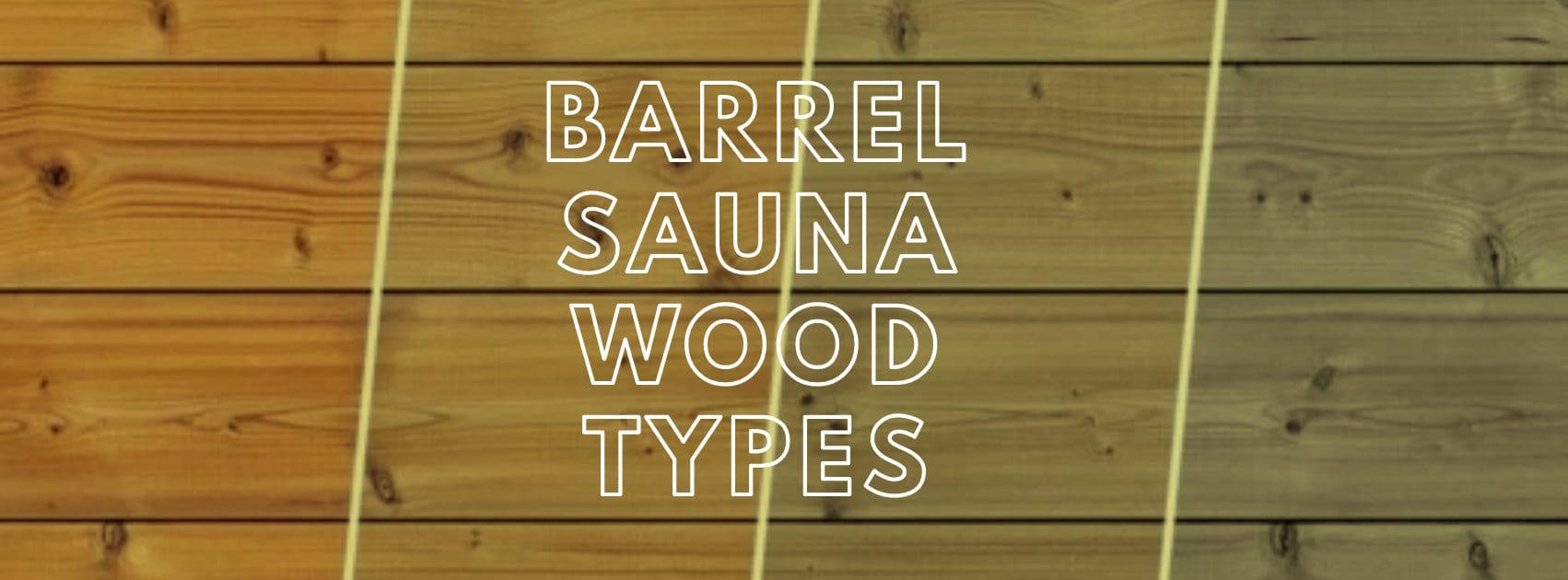
Barrel saunas are becoming increasingly popular due to their unique shape, efficient heating, and affordable wellness experience they provide. These saunas are designed to provide a relaxing and rejuvenating environment for people to unwind and detoxify. Like sauna tents, they are an affordable way to have a home sauna without taking out a second mortgage.
One critical aspect of building a any sauna is the wood type used in its construction and barrel sauna wood types are often overlooked.
Just as important as the wood type is the quality and treatment of the wood. The best barrel saunas now use thermally treated wood that naturally enhances the durability and stability of the wood without any chemicals.
Most non-savvy buyers don’t consider barrel sauna wood types because manufacturers may only sell one option. It’s the most important decision but hardly discussed on product pages.
The wood type used in constructing a barrel sauna determines its durability and longevity and impacts the sauna’s overall performance and insulation properties. Choosing the right wood type ensures that your sauna can withstand the test of time while providing you with a comfortable and inviting space.
Popular Barrel Sauna Wood Types
Cedar
Cedar is the most common and highly recommended wood type for barrel saunas. It has excellent insulation properties, resistance to decay, and a pleasant aroma. There are two types of cedar commonly used in barrel saunas:
Western Red Cedar Barrel Saunas
Western Red Cedar is highly regarded for its natural beauty, warmth, and rich color. It has a straight grain and uniform texture that makes it ideal for sauna construction. Additionally, it is highly resistant to decay, making it a long-lasting option. We recommend Nomad Saunas for their custom western red cedar barrel saunas.
Overall, we don’t think Western Red Cedar makes sense as a sauna wood anymore. It’s too expensive, and the quality has gone down tenfold since old growth forests were exhausted. Cedar today barely resembles the saunas we were building 20 years ago.
Additionally, Western Red Cedar has some of the highest VOC content, making it an irritant for 1 in 5 people. In fact, some people are allergic to it. They don’t have Western Red Cedar in Europe, but we do not believe the traditional Finnish sauna builders would have used it anyway. That’s what they tell us anyway.
Northern White Cedar Barrel Saunas
Northern White Cedar is another popular choice for barrel saunas. It is lighter in color compared to Western Red Cedar but still offers excellent insulation and decay resistance. White Cedar also has attractive tight knots. Northern White Cedar is also a more budget-friendly option, but won’t resist termites as well as Western Red Cedar. However, the aroma is not as extreme so it’s better for people sensitive to the smell of cedar, and for anyone who wants to use essential oils in their sauna.
We like Northern White Cedar barrel saunas from Dundalk.
Hemlock Barrel Saunas
Hemlock is another popular choice for barrel saunas due to its affordability and attractive appearance. It has a light, consistent color, and a fine grain. While it may not be as decay-resistant as cedar, it still provides excellent insulation properties and durability when properly maintained.
Nordic Spruce Barrel Saunas
Spruce is a more affordable option for barrel sauna construction. It has a lighter color and a straight grain, which gives it a clean and modern appearance. Although it has less natural resistance to decay than cedar, it can still last many years with proper care and maintenance.
With Thermal Modification, Nordic Spruce is as good as it gets – outlasting cedar and becoming the most dimensionally stable material for barrel saunas. Dimensionally stable means you are less likely to deal with warping, a door that won’t close, and gaps in your sauna through the years.
As the quality of cedar continues to decline with old growth forests, thermally modified wood has become the choice for the best barrel saunas. Builders can save over 25% in both time and material waste by using a more stable and straight barrel sauna wood type like modified Nordic Spruce.
High end European manufacturers like Thermory and SaunaLife exclusively use thermally modified Nordic Spruce. It pairs very well with Thermo-Aspen benches, which is the combination used by both Thermory and Auroom.
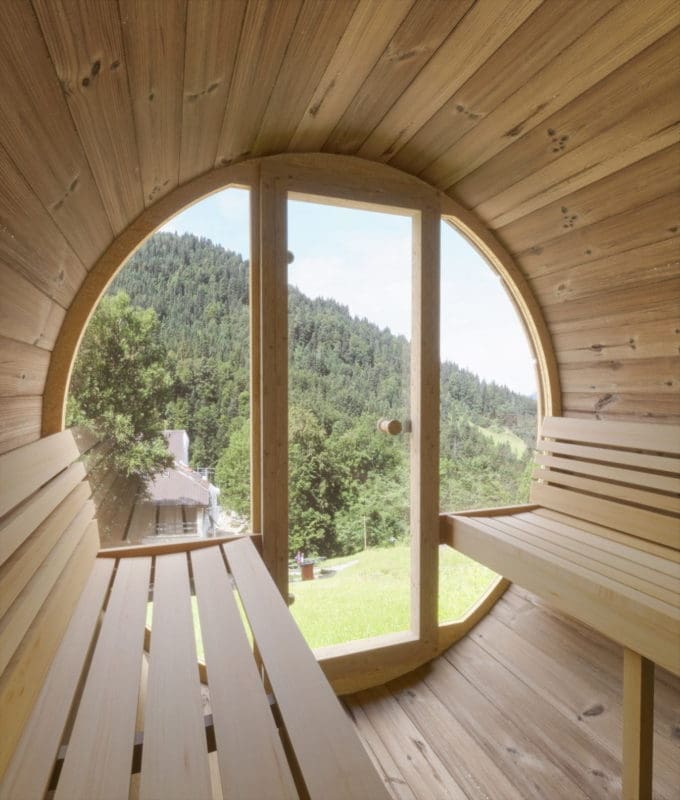
Pictured: The SaunaLife Ergo Glass in Thermally Modified Nordic Spruce with Aspen Benches. Check Out SaunaLife Barrel Saunas here
Standard Pine and Spruce Barrel Saunas (DIY)
Pine is the least expensive option for barrel sauna construction but offers a lower level of decay resistance and insulation properties. Pine is typically chosen for its budget-friendliness and availability. However, it requires more maintenance and may not last as long as other wood types.
If you’re willing to paint your barrel sauna, or cover 2/3 in a roof then Pine is a good option. We recommend B2B Cabins and Outdoors for their pine barrel sauna kits. They have some extra large, and unique options available shipping from New Jersey. Use code ‘SaunaShare’ for a discount.
Pine is also the most popular wood choice for DIY barrel sauna builds because builders can use standard 2×6 lumber from the hardware store. Building a DIY barrel sauna is a fun project but incredibly tricky and time consuming due to the joinery required. If you’re interested, check out our guide to DIY Barrel Sauna Building.
Black Barrel Saunas (Shou Sugi Ban)
Shou Sugi Ban and Yakisugi are Japanese methods for preserving wood using a fire. It works best with soft woods like cedar so it’s a great choice for barrel saunas.
Barrel saunas can also be turned black using thermal modification, wax, and paint. Shou Sugi Ban and thermal modification are the best looking and performing options.
Check out the Thermory Ignite black barrel sauna for the most striking black sauna on the market. Our selection of black sauna woods available in North America can be seen here.
Read all about the methods and options for black sauna wood here.
Factors to Consider When Choosing Wood Types
Durability and Rot Resistance
When selecting a wood type for your barrel sauna, consider its resistance to decay and rot. Wood types with high decay resistance, like cedar, will ensure that your sauna lasts longer with less maintenance.
Aesthetic Appeal
Choose a wood type that complements your personal
style and the aesthetic of your surroundings. Some wood types, like Western Red Cedar, offer a richer color and more distinctive grain pattern, while others, like pine, have a simpler and lighter appearance.
Insulation Properties
The wood type you choose should have good insulation properties to maintain a consistent temperature inside the sauna. Cedar and hemlock are known for their excellent insulation capabilities, while pine may not perform as well in this regard.
Cost
Your budget will play a significant role in determining the wood type you choose for your barrel sauna. Cedar tends to be the most expensive option, while pine is the most affordable. Consider the long-term investment and weigh the benefits of each wood type against their cost.
Barrel Sauna Wood Treatment and Maintenance
Thermal Modification
As mentioned in our Nordic Spruce discussion, thermal modification is a game changer in barrel saunas. The natural process uses a combination of heat and steam to make the wood much more durable and stable.
In fact, we only sell thermally modified barrel saunas directly on Sauna Marketplace. The quality of cedar has become too unpredictable and prices rise, and you can clearly see the problems Costco and Almost Heaven are having sourcing quality cedar as their primary barrel sauna wood type.
Check out Thermory and other thermally modified barrel sauna wood types here.
Preservatives and Sealants
To prolong the life of your barrel sauna, it’s essential to use wood preservatives and sealants, especially for wood types with lower decay resistance. These treatments will protect the wood from moisture, insects, and other damaging factors, ensuring your sauna’s longevity.
Cleaning and Maintenance
Regular cleaning and maintenance are crucial for any wood type you choose for your barrel sauna. This includes removing dirt, debris, and any buildup of mold or mildew. Periodic inspections for signs of damage, decay, or insect infestations will help keep your sauna in top condition.
Conclusion and FAQs
Selecting the right wood type for your barrel sauna is a crucial decision that impacts its durability, insulation, and overall appearance. Cedar, hemlock, spruce, and pine are popular choices, each with its unique benefits and drawbacks. By considering factors like decay resistance, aesthetic appeal, insulation properties, and cost, you can make an informed decision and enjoy your barrel sauna for years to come.
- What is the best wood type for a barrel sauna? Cedar is the most recommended wood type for barrel saunas due to its excellent decay resistance, insulation properties, and pleasant aroma. However, thermal modification is now a popular way to achieve a more stable, durable, and affordable barrel sauna using Nordic Spruce and other materials.
- Are there any budget-friendly wood types for barrel saunas? Yes, spruce and pine are more budget-friendly options for barrel saunas, although they may not offer the same level of decay resistance and insulation properties as cedar unless they are Thermally Modified.
- How often should I maintain my barrel sauna? Regular maintenance, including cleaning and inspections, should be performed at least once a year, or more often if you notice any signs of damage, decay, or infestations. Your barrel sauna will naturally fade in color no matter what type of wood you choose unless you treat it with stain, parafin oil, or similar.
- Can I paint or stain my barrel sauna? Yes, you can paint or stain your barrel sauna to change its appearance or add extra protection, but be sure to choose products specifically designed for saunas and follow the manufacturer’s guidelines.


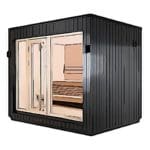 Prebuilt
Prebuilt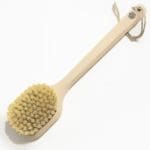 Sauna Brushes
Sauna Brushes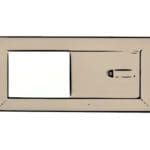 Vents
Vents